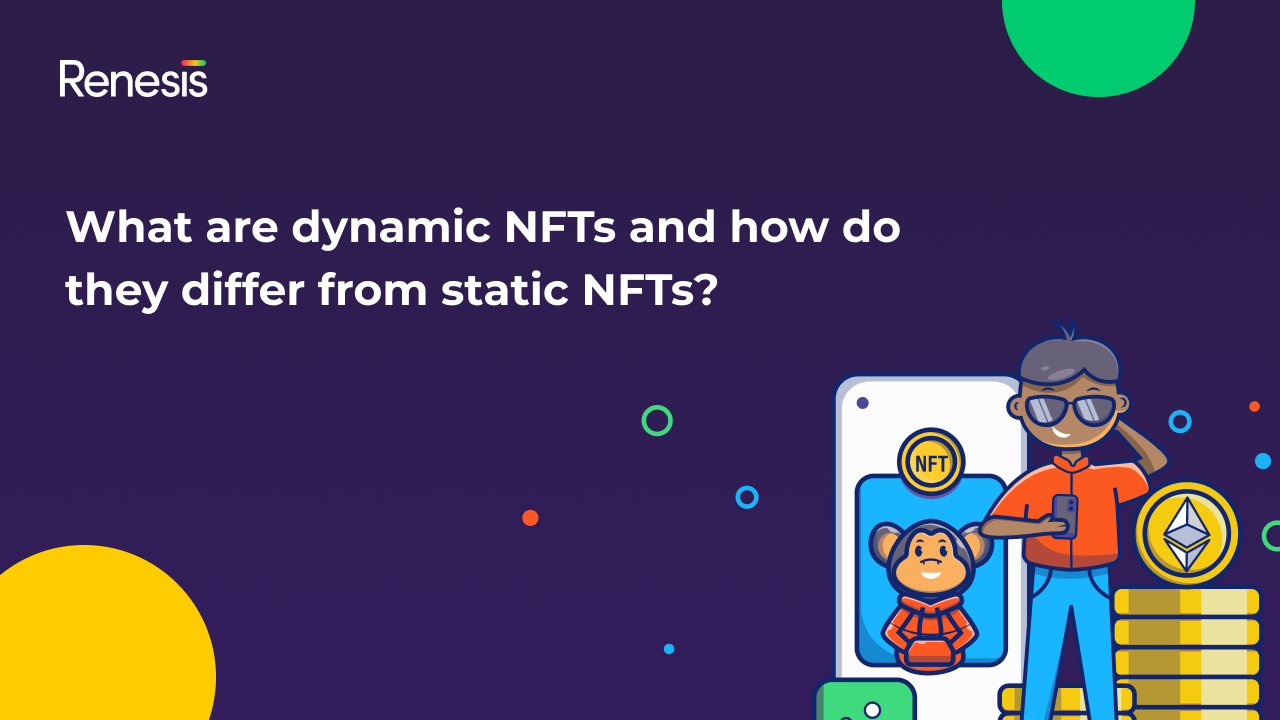What are dynamic NFTs and how do they differ from static NFTs
In the crypto world, non-fungible tokens (NFTs) have become increasingly popular. As a result of their popularity and ubiquity, NFTs are quickly becoming one of the most recognized and popular applications of blockchain technology. Using dynamic NFTs, we’re now experiencing a multitude of exciting new possibilities.
Before we dive into Dynamic NFTs, let’s take a look at what NFTs are and how they work?
What is an NFT?
A non-fungible token (NFT) represents ownership of one or more digital or physical assets as a unique (non-fungible) blockchain token. This can be a graphic, video, audio recording or animation, a play-to-earn game asset, or even a patent or real estate title.
Creating an NFT (“minting”) involves only storing a URL link to metadata stored on the InterPlanetary File System (IPFS), a decentralized data storage system. Additionally, the metadata contains a link to the NFT’s content on IPFS, as well as the token’s name and other information.
What are Dynamic NFTs?
It seems that the NFT sector has something unique to offer. It is predicted that dynamic NFTs will change the NFT industry trends radically. There has been an uproar over dynamic NFTs, including merge and OG crystals, in the cryptocurrency market. In a few years, dynamic NFTs will be the next big thing, according to many enthusiasts.
The majority of NFTs you’ve seen and possibly traded are “static” NFTs. These are stored on IPFS with locked metadata that cannot be changed. Tokens that are static are defined by Ethereum’s ERC-721 token standard, which requires smart contracts to be executed for each new token.
In a dynamic NFT, the behavior of the token changes as a result of factors outside the network, either on or off the network.
Dynamic NFTs: Why do we need them?
NFTs can be traded on blockchain-based platforms. Although blockchain offers a secure environment, it does have some limitations. Due to these security measures, NFTs cannot communicate with data outside of the blockchain. Dynamic NFTs were developed specifically to resolve this concern.
Why do dynamic NFTs work?
The technology behind smart contracts enables dynamic NFT agreements to be changed in accordance with on-chain and off-chain operations. Based on estimates of off-chain and on-chain data, smart contracts decide what response to display to users when an NFT (non-fungible token) is initiated.
As a result of calculating both off-chain and on-chain data, the smart contract only gives the requestor one or two responses. It implies that smart contracts play an important role in enabling NFTs to change, update, and evolve over time.
Therefore, smart contracts decide whether or not to change the NFTs, and if they do, they change the metadata of a dynamic NFT using both on-chain and off-chain information.
Dynamic NFTs Benefits
A flexible smart contract on a dynamic NFT allows it to evolve over time in response to real-world events, according to a leading NFT marketplace development company. Users can use this attribute to transfer NFTs between different blockchains and even change their perspective upon changing ownership of NFTs.
Furthermore, dynamic NFTs can be used for ticketing, P2P gaming unit trading, and real-world fantasy sports. It is also anticipated that dynamic NFTs, such as the dynamic Shield NFT, would also possess the verifiable randomness function (VRF).
DNFTs Use Cases
Metadata needs to be updated frequently, so dynamic NFTs are beneficial. Here are a few conceptual and real-world examples:
Gaming
When DNFT’s metadata is first deployed, it captures the qualities of the in-game character for the very first time. In order to reflect a character’s development as it “levels up” and improves, the metadata can simply be modified.
An alternative approach is to automatically distribute DNFTs based on a player’s performance.
Real Estate
This sector is gaining popularity for Dynamic NFTs. Consider a family house that has been tokenized as a DNFT and listed for sale, where the holder also owns the actual title deed.
Property values fluctuate over time as maintenance is carried out. In the metadata of the DNFT, these changes will be reflected instantly.
Sports
Another example would be sports collectibles or sports cards. Consider a dynamic NFT that represents a real football player. A variety of variables may be contained in the metadata of the NFT, such as speed, body composition, height, shots on goal, and assists.
It is likely that information recorded by a player during a season will change over time. Dynamic NFTs automatically update metadata based on facts, unlike static NFTs.
Hopefully, this guide has helped you understand “what are dynamic NFTs?”. If you’d like to learn more about NFTs and the crypto industry in general, feel free to browse the Renesis blog. You’ll find relevant information on several aspects of blockchain development.










